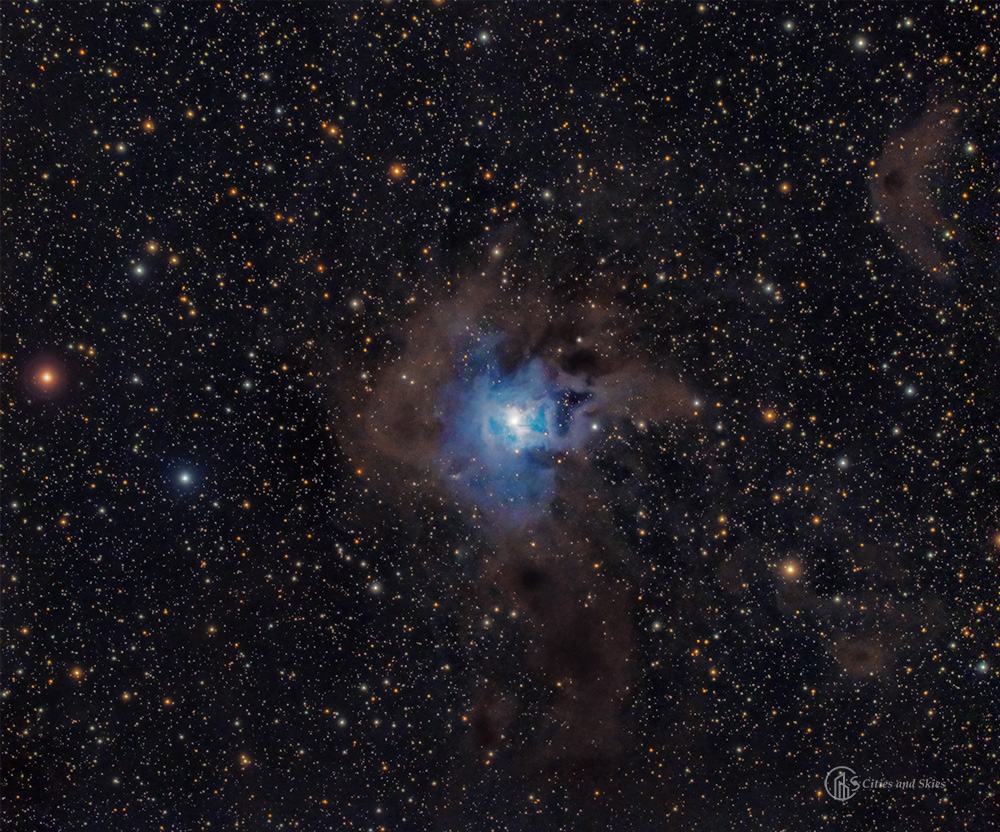How does it look like, the birth of stars? Are they easy to spot? Or are they hiding somewhere? Hot stars (like Menkib) can produce massive regions of glowing gas known as emission nebulae. Often these are sites of massive star formation, like in the Elephant’s Trunk Nebula or the Orion Nebula. They emit light only at a few specific frequencies (=colors). Reflection nebulae on the other hand glow in a different way and emit light in the full spectrum (all colors!). Although they usually appear blue, like the Pleiades. But when we see a star in a nebula with a mixture of these properties, we found something very special: a Herbig-Haro object. These represent small- to mid-range mass stars in the making.
How do these objects shine?
Reflection nebulae scatter starlight off microscopic dust particles. We know that dust in space signifies the life cycle of stars. Where there is gas and dust, there are stars in the making – if the conditions are right. As the gas clouds collapse, they form a dusty disc around the proto-star. This is a process called accretion, and it is regulated by the magnetic fields in the disc. The stars spin up, and they expel some of the gas along their rotational axis. These outflows (collimated jets, like in HH111) introduce shocks in the interstellar medium, and they appear as moving, compact emission nebulae. The youngest of these stars embedded in Herbig-Haro objects are not even burning hydrogen in their core yet, they are powered purely by gravity.
The Iris Nebula
Also known as Caldwell 4, the Iris Nebula (shown in the image) and the associated star cluster NGC 7023 lie in a region called the Cepheus Flare. This is a site of low and intermediate-mass star formation, at a distance of around 1000 light years from the Sun. In the center of the nebula, V380 Cep (or HD 200775) is a Herbig-Haro star. Its light is scattered by dust particles 10-100x smaller than dust on Earth, making the nebula blue. But there are darker, red-brownish filaments colored by compounds we do not know. Scientists are investigating this area to reveal what ingredients stellar systems (including planets) are made of.
Stars (and Planets) in the making
There are a number of other, similar objects within the blue reflection nebula, and its surroundings. This region is of particular interest because the star formation processes are somewhat different for low- and high-mass stars. The division line is somewhere between ~2-8 Solar masses, the range of masses for proto-stars and young stellar objects we find here. The latest studies also show that the objects found in NGC 7023 (around V380 Cep) are moving outwards from the center of the Cepheus Flare Shell, indicating that their formation was triggered by a past explosive event (like a supernova). There have been similar findings for other groups of young stars in the broader region.
Ohh, just one more thing…
The red, bright star photo-bombing our image in the left is T Cephei, a red supergiant. It is not quite as large as the hypergiant Erakis (Herschel’s Garnet Star), but it is still 300x bigger than the Sun. The brightness of this star radically changes, it is a Mira-type variable star.
References
Hubble’s Caldwell Catalog: Caldwell 4
ESA/Hubble
Kun et al. (2008), Handbook of Star Forming Regions Vol. I, ASP, 2008
Kun et al. (2009), ApJS, 185, 451
Saha et al. (2021), A&A, 653, A142
Observing log
Shooting spread over several nights (28, 30, 31 May, 2 June 2021), various conditions. Very warm during the day, but quickly cooling in the evening (except for the very warm last night).
Exposure time: 50 x 10 min = 500 min. All shot with gain 101, at -20 degrees Celsius (-10 deg. at the beginning of 31 May, and during the last night).
Telescope: William Optics GT81, f/5.9, with Flattener 6AIII 0.8x
Camera: ZWO ASI533MC-P
Guidescope: WO Uniguide 50/200 with ASI120MMmini
Mount & control: iOptron CEM40, ASIair Pro
Filter: Optolong L-Pro
Software: Astro Pixel Processor, Photoshop
